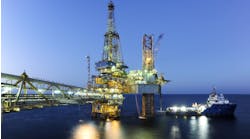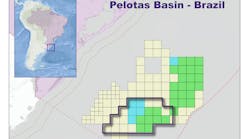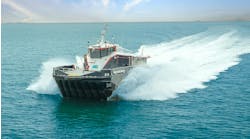There is good news for the GOM pipe laying and burial contractors: the down turn for contractors appears to be over or almost over. This is heartening news indeed for those contractors who have suffered through two very dismal years.
How dismal was it? According to the results of the 4th annual Survey of Offshore Pipeline and Burial Contractors conducted by Mustang Engineering, Inc. and Offshore Magazine, the demand for pipelay services decreased 6.14% from 1998 and 27.76% from the peak year in 1997. In addition, the demand for burial services decreased 30.8 % from 1998 and 63.2% from the peak year in 1997 for burial footage.
Contractors have pointed out that 1999 was another tough year. It was worse than 1998, which was also considered a down year. Contractors were hit by both a drop in the amount of footage and also by lower vessel rates.
"1999 was definitely a bad year, even for the big guys," stated Patrice Chemin, President of Torch. He said one of the reasons there was less activity in 1999 was because "the majors have been so busy buying each other, the process brings delay in the decision making for field developments." In his opinion, Chemin said that "consolidation had not been good for the contractors."
The low oil prices of 1998 and early 1999 produced a climate in which the independent operators and majors canceled or postponed field development projects in order to cover debt and focus on profits for their shareholders.
Although the footage laid in 1999 decreased only 6.14% from 1998 totals, 1999 was a particularly tough year for the shallow water contractors. Most of the footage shifted from shallow water to deepwater. Allseas, a deepwater contractor, captured a much larger share of the US Gulf market and then left the area for other major international pipeline projects.
Pipelay performance
Five contractors dominated the pipeline installation market for the past four years (1996-1999). The pipelay equipment personnel from these five contractors - Allseas, Global Industries, Horizon Offshore, J. Ray McDermott, and Torch - accounted for 87.35% of the total footage laid in 1999.
In 1999, a total of 6,430,071 ft of rigid pipe and continuously milled line pipe (coiled tubing or coiled line pipe) was laid in state and federal waters in the US Gulf. This footage compared with 6,851,081 ft of pipe laid in 1998.
The survey shows that Allseas took the lead away from Global Industries in 1999 by laying 1,920,926 ft of pipe, which represents 29.87% of all footage laid in 1999. Allsea's 1999 total footage was 71.2% higher than their 1998 footage of 1,122,046 ft. In 1999, the deepwater pipelay work was sufficient enough to attract both Allseas vessels, the Lorelay and the Solitaire, to the Gulf of Mexico. Most of the footage installed in 1999 was for the Exxon Diana project.
Global Industries laid the second most total footage in the US Gulf in 1999 with 1,241,160 ft of pipe, compared with 1,501,632 ft of pipe laid in 1998. This represents a 17.34% drop in year-to-year footage laid from 1998 to 1999. In 1999, Horizon Offshore again laid the third most footage of pipe with 1,004,912 ft in the US Gulf. This total footage represents a 6.3% decrease in total footage in comparison to 1998.
Although J. Ray McDermott was in fourth place for total footage, they were technically ahead of competitors. They were the only contractor to J-lay pipe-in-pipe (PIP) in the US Gulf in 1999. According to McDermott, the PIP system for Shell's Europa project is the deepest and largest PIP system in the US Gulf. They laid 124,608 ft of 6 in. by 10 in. and 190,080 ft of 8 in. by 12 in. PIP systems. In order to normalize McDermott's footage with that of the other contractors , the total length of the carrier and jacket pipes were taken into account for determining McDermott's footage.
The most common pipe sizes in 1999 were 20 in., 6 in., 8 in., and 4 in. By comparison, the top four sizes in 1998 were 6 in., 4 in., 12 in., and 24 in.
Burial performance
In 1999, 36.35% of the total footage of pipe laid in the US Gulf was buried, a total of 2,337,558 ft of pipe. This compares to 3,378,615 ft of pipe buried in 1998, a 30.8% drop in burial footage.
In 1998, only 49.3% of the total footage laid was buried. During the peak year of 1997, 71.4% of the total footage of pipe laid was buried. The footage decline since 1997 indicates a trend of laying in deeper water where pipe burial is not required.
In terms of burial footage on total rigid and coiled tubing footage for US Gulf contractors in 1999, the three dominant contractors (84% of footage for 1999) were: Horizon Offshore, Global Industries, and Torch.
For the second consecutive year, Horizon Offshore Contractors was the number one contractor for the total length of pipe buried in the US Gulf. They buried 790,717 ft of pipe in 1999, compared to 1,087,240 ft in 1998, a 27.27% decrease. Global Industries was ranked in second place with 638,880 ft of total feet of pipe, an increase of 19.2%. Torch was third with 536,100 ft of buried pipe in 1999, a 0.2% decrease from 1998.
Pipe installation trends
The following items represent some of the emerging trends within the pipelaying sector of the industry in the Gulf of Mexico:
- The percentage of deepwater pipe footage, versus shallow water footage, will begin steadily increasing in 2001 as deepwater projects commence construction.
- The US Gulf deepwater market is continuing to attract more European contractor vessels that can perform multiple functions, including pipelay.
- The market share of coiled tubing used for flowlines is expected to increase each year.
- Umbilical installation footage is expected to increase along with an increase in subsea tree installations in the US Gulf.
- Contractors are increasing their focus on reel laying of rigid pipe. More contractors are installing racks in their yards so that they can prepare and load their own reel lay vessels.
- Barges and vessels are being upgraded with dynamic positioning (DP) capability for deepwater pipelay operations.
- More contractors are offering J-lay capability.
- More flexible pipe will be installed for deepwater infield flowlines.
- The installation of export pipelines, flowlines, and umbilicals in deepwater is requiring more sophisticated pipelay capability in the US Gulf.
- More contractors are actively bidding on deepwater work in the US Gulf. For example, DSND has officially opened an office in Houston to pursue deepwater work in the US Gulf as well as other international work.
- Reel laying of steel catenary risers (SCR) will become a reality in the near future as more owners become comfortable with the technology.
- Reel laying of pipe-in-pipe will become increasingly popular in the US Gulf in the near future.
- The number of insulated flowlines will steadily increase with deepwater pipeline installations.
- The installation of in-line Ts and piggable Ys for future tie-ins are increasingly being used on deepwater installations.
- Pipeline routing is becoming a more critical design step with deepwater pipelines because the sea floor is much more rugged in deepwater than it is on the Continental Shelf.
- Pipe wall thicknesses will steadily increase up to 1-1/4 in. as pipelines go into deeper water.
- Pipe mills are increasing their capability to supply high quality pipe for deepwater installations.
- Industry opinions continue to differ about the advantages and disadvantages of S-lay versus J-lay in deepwater.
- Pipeline span analysis and solutions will be come increasingly more important as pipe lines are laid in the deepwater with rugged terrain.
- Pipeline owners and contractors are becoming increasingly more aware of the importance of having enough dynamic positioning (DP) horsepower to lay pipelines in deepwater with the correct amount of tensioning.
- There is a standardization toward upper looking hubs for PLEMs, PLETs, etc.
- Three major operators - Shell, BP Amoco, and ExxonMobil - appear to prefer long term contractor relationships.
- Most of the operators prefer to use a general contractor approach for their contracting strategy.
Coiled tubing
The market share for installation of coiled tubing in the US Gulf is increasing on a footage and percentage basis. In the past two years, the percentage of coiled line pipe has more than doubled. Jim Donnelly of Precision Tubing, a manufacturer of continous three-layer coated line pipe, attributes the increase to the fact that the market is getting educated to the characteristics of the material.
Skipper Strong of Cal Dive believes that education about the product, improved flow characteristics, availability of the product, reduced handling time, and cost have all contributed to the increased use of coiled tubing for pipelines and flowlines. According to Skipper, a major contracting advantage when installing coil tubing is that "the operator only deals with one contractor for the pipe procurement, delivery, and installation, versus multiple companies when rigid pipe is used." Patrice Chemin of Torch refers to coiled tubing as the "product of the future."
Coiled tubing is primarily being used for flowlines. As confidence and the knowledge of coiled tubing for flowline application increases, the tubing will be used in deeper water. In April of 2000, Oceaneering installed dual 4-1/2 in. flowlines, each over 15,000 ft in length, for Mariner Energy's Apia Project in 743 ft water depth, a new US Gulf record water depth record for coiled tubing. Later in 2000, Mariner Energy will install the world's deepest application of coiled tubing for their Black Widow project in 1,890 ft of water.
Donnelly also points out that "in November 1999, the API 5LCP Specifications for Coiled Line Pipe document was formally issued to the industry, a further level of pier review and acceptance of the product." Donnelly anticipates that the use of coiled tubing for flowlines and pipelines will increase as the pipe market returns to normal. In 1999, a large inventory of standard rigid pipe drove down pipe prices. The combination of lower material costs and lower installation costs for rigid pipe competitively reduced the growth of coiled line pipe in 1999.
There were four contractors who installed coiled tubing in 1999. The leader is Quality Tubing, with 233,000 ft, or 51.46% of the market. Quality is both a manufacturer and installer for water depths less than 50 ft of water. Cal Dive was number two, with 33.9% of the market. They were also the leader in the industry for installing the most footage in water depths greater than 200 ft.
Cal Dive is building two new vertical reels for coiled line pipe installations for the Witch Queen and Cal Dive Aker Dove vessels. Oceaneering will be making their Ocean Intervention II available to the industry in 3rd quarter of 2000.
J-laying pipe
Until 2000, the only contractor with J-lay capability for large diameter pipe in the US Gulf deepwater was J. Ray McDermott, using its DB50. In 1999, McDermott J-layed pipe-in-pipe out to 4,400 ft for Shell's Macroni and Europa projects. In 2000, Saipem introduced their J-lay capability to the US Gulf. Saipem used the S7000 to J-lay infield flowlines on the Exxon Diana project.
Heerema is expected to introduce J-lay capability onboard the Balder to the US Gulf in October of 2001. Coflexip Stena Offshore will bring J-lay capability to the US Gulf with their new vessel, CSO Deep Blue, in May 2001.
According to the 2000 US Gulf pipelay survey, a total of 20 vessels based in the US Gulf are being bid on jobs that will have J-lay capability. By comparison, only eight vessels were being marketed with J-lay capability in 1999. The majority of contractors are outfitting their vessels for deepwater by going to the J-lay system.
Reeled rigid pipe
There appears to be a great deal of interest in reel laying of rigid pipe among contractors. At least five contractors either have, or are in the process of building spooling yards for onshore welding of rigid pipe. They are Global Industries, Cal Dive, DS & D, Torch, and Stolt Offshore.
Global Industry is presently modifying their Hercules vessel for reel laying. The vessel is scheduled to be available in July 2000 for reel laying of rigid pipe or conventional S-lay. In December of 1999, Global Industries opened their new yard in Carlyss, Louisiana with a pipe assembly rack of 2,790 ft in length for reeling pipe on the Hercules and Chickasaw vessels. Cal Dive is building the Q-4000 with two removable reels that are loaded from the underside of the deck by barge transport. The Q-4000 is scheduled to be available July 2001.
Torch is building a rigid pipe spooling yard in Dulac in support of their DP vessel Midnight Eagle, which can reel lay rigid pipe in water depths of 30 ft to 1,000 ft.
"We want to reel lay in shallow water using a DP system," explained Patrice Chemin. Torch's SAS reel lay system is modular and can be moved onto either the Midnight Carrier or Midnight Eagle.
Umbilicals
For the first time the 2000 US Gulf Survey surveyed and ranked the pipelay contractors who also install umbilicals. A total of 959,846 ft of umbilicals were installed in 1999. Stolt Offshore and Oceaneering were virtually tied for first place for the most umbilical footage installed in 1999. Together they installed 71.78 % of the total footage.
Four contractors installed umbilicals in 1999. The survey showed that 10 contractors indicated they have vessels that can install umbilicals. By contrast, the 1999 survey showed that only six contractors indicated this capability. Contractors are anticipating an increase in this market segment.
Pipelaying future
The shallow water pipelay market is expected to recover in 2000 from two low activity years. Patrice Chemin said that his firm has been extremely active in the bidding process. "In the 1st quarter of 1998 we bid on $40 million worth of work, $53 million in 1st quarter of 1999, $128 million in the 1st quarter of 2000." In contrast, Neil Crain of Crain Brothers doesn't see a lot of work for the shallow water market in the transition zone (40 ft to the beach) until 2001.
Larry McClure, Vice-President at Global Industries, says that Global sees a lot of AFEs (authorization for expenditure) for potential work in 2001 and beyond. The number of AFEs requested by operators are an early indicator of future bidding activity level. McClure believes that the market in the next three years will steadily pick up. He likens the 2001 market to a 6 in. pie, 2002 as a 10 in. pie, and 2003 as a 15 in. pie.
The deepwater pipelay market is expected to take off in 2001. One installation contractor anticipates the West Africa and the US Gulf markets to heat up at the same time. John Reed of Heerema also foresees a pending shortage of equipment and personnel in the future. Reed sees a lot of future work for huge projects ready to be awarded starting in the 3rd or 4th quarter of 2000. Reed describes the future work as "an explosion over the horizon."
Authors
E. Kurt Albaugh PE is a Senior Consulting Engineer at Mustang Engineering, Inc., specializing in economic, cost, and feasibility studies for offshore and onshore field developments. He holds a BSCE from Youngstown State University and a MCE from Rice University. He is also Poster Editor and Technical Advisor for Offshore magazine
Tillie Nutter has been employed by Mustang Engineering since 1998 in the business development department, providing support for marketing and proposal development.


